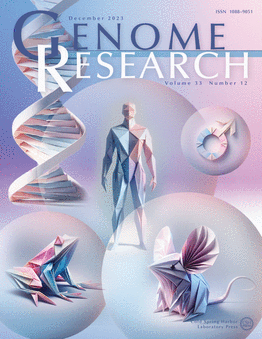Complete genomes of Asgard archaea reveal diverse integrated and mobile genetic elements
IF 6.2
2区 生物学
Q1 BIOCHEMISTRY & MOLECULAR BIOLOGY
引用次数: 0
Abstract
Asgard archaea are of great interest as the progenitors of Eukaryotes, but little is known about the mobile genetic elements (MGEs) that may shape their ongoing evolution. Here, we describe MGEs that replicate in Atabeyarchaeia, a wetland Asgard archaea lineage represented by two complete genomes. We used soil depth–resolved population metagenomic data sets to track 18 MGEs for which genome structures were defined and precise chromosome integration sites could be identified for confident host linkage. Additionally, we identified a complete 20.67 kbp circular plasmid and two family-level groups of viruses linked to Atabeyarchaeia, via CRISPR spacer targeting. Closely related 40 kbp viruses possess a hypervariable genomic region encoding combinations of specific genes for small cysteine-rich proteins structurally similar to restriction-homing endonucleases. One 10.9 kbp integrative conjugative element (ICE) integrates genomically into the Atabeyarchaeum deiterrae-1 chromosome and has a 2.5 kbp circularizable element integrated within it. The 10.9 kbp ICE encodes an expressed Type IIG restriction-modification system with a sequence specificity matching an active methylation motif identified by Pacific Biosciences (PacBio) high-accuracy long-read (HiFi) metagenomic sequencing. Restriction-modification of Atabeyarchaeia differs from that of another coexisting Asgard archaea, Freyarchaeia, which has few identified MGEs but possesses diverse defense mechanisms, including DISARM and Hachiman, not found in Atabeyarchaeia. Overall, defense systems and methylation mechanisms of Asgard archaea likely modulate their interactions with MGEs, and integration/excision and copy number variation of MGEs in turn enable host genetic versatility.阿斯加德古菌的完整基因组揭示了多样化的整合和移动遗传元素
阿斯加德古菌是真核生物的祖先,因此备受关注,但人们对可能影响其持续进化的移动遗传因子(MGEs)却知之甚少。在这里,我们描述了在阿塔贝古细菌(Atabeyarchaeia)中复制的移动遗传因子,这是一个由两个完整基因组代表的湿地阿斯加德古细菌系。我们利用土壤深度分辨种群元基因组数据集追踪了 18 个 MGEs,这些 MGEs 的基因组结构已经确定,而且可以识别出精确的染色体整合位点,以确定宿主联系。此外,我们还通过 CRISPR spacer targeting,鉴定出了一个完整的 20.67 kbp 环状质粒和两个与 Atabeyarchaeia 相关的科级病毒群。密切相关的 40 kbp 病毒拥有一个超变异基因组区域,编码结构类似于限制性归巢内切酶的富含半胱氨酸小蛋白的特异基因组合。一个 10.9 kbp 的整合共轭元件(ICE)在基因组上整合到 Atabeyarchaeum deiterrae-1 染色体中,并在其中整合了一个 2.5 kbp 的可循环元件。10.9 kbp 的 ICE 编码一个表达的 IIG 型限制性修饰系统,其序列特异性与太平洋生物科学公司(PacBio)高精度长读数(HiFi)元基因组测序确定的活性甲基化基序相匹配。Atabeyarchaeia的限制性修饰与另一种共存的阿斯加德古菌Freyarchaeia的限制性修饰不同,Freyarchaeia几乎没有被鉴定出的MGEs,但却拥有多种防御机制,包括Atabeyarchaeia所没有的DISARM和Hachiman。总之,阿斯加德古菌的防御系统和甲基化机制很可能调节了它们与MGEs的相互作用,而MGEs的整合/切割和拷贝数变异反过来又使宿主的遗传多样性得以实现。
本文章由计算机程序翻译,如有差异,请以英文原文为准。
求助全文
约1分钟内获得全文
求助全文
来源期刊

Genome research
生物-生化与分子生物学
CiteScore
12.40
自引率
1.40%
发文量
140
审稿时长
6 months
期刊介绍:
Launched in 1995, Genome Research is an international, continuously published, peer-reviewed journal that focuses on research that provides novel insights into the genome biology of all organisms, including advances in genomic medicine.
Among the topics considered by the journal are genome structure and function, comparative genomics, molecular evolution, genome-scale quantitative and population genetics, proteomics, epigenomics, and systems biology. The journal also features exciting gene discoveries and reports of cutting-edge computational biology and high-throughput methodologies.
New data in these areas are published as research papers, or methods and resource reports that provide novel information on technologies or tools that will be of interest to a broad readership. Complete data sets are presented electronically on the journal''s web site where appropriate. The journal also provides Reviews, Perspectives, and Insight/Outlook articles, which present commentary on the latest advances published both here and elsewhere, placing such progress in its broader biological context.
 求助内容:
求助内容: 应助结果提醒方式:
应助结果提醒方式:


